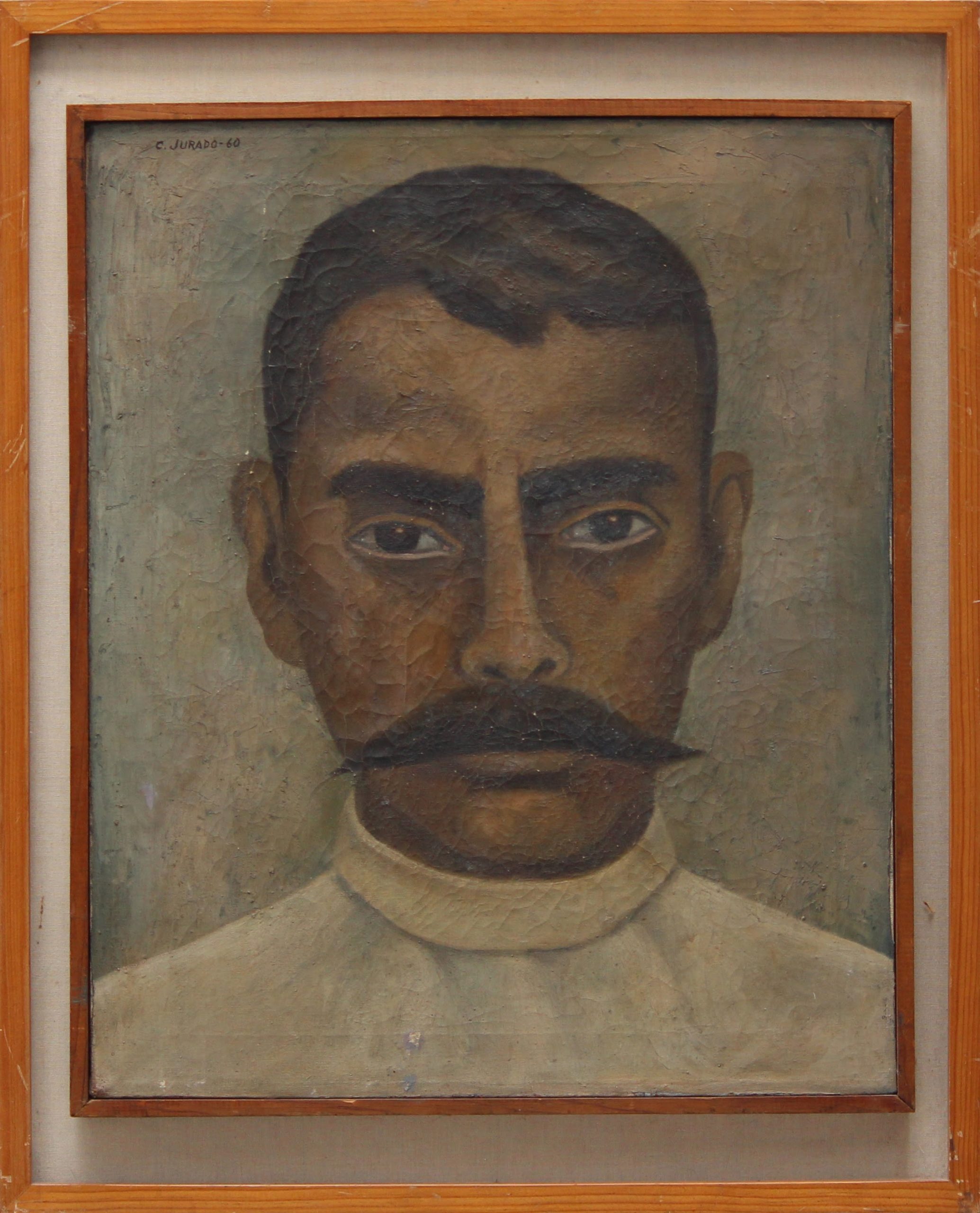RENI ALVAREZ COLLECTION
RENI ALVAREZ COLLECTION
CARLOS JURADO

CARLOS JURADO
«RETRATO DE EMILIANO ZAPATA»
SIZE: 57 X 48 CM
OIL ON CANVAS
MÉXICO 1960
CONTACT US FOR PRICING
Carlos Jurado (1927-2019), was a Mexican painter, muralist and photographer whose work was characterised by the experimentation of ancient photographic processes. He is representative of the creation of this type of images and techniques, the result of visionary thinking and an alchemist spirit.In 1944, Carlos Jurado began painting studies at La Esmeralda with prominent teachers such as Antonio Ruiz el Corso, and María Izquierdo. In 1951 he would have his first contact with photography, when he worked for the National Indigenous Institute, visiting indigenous areas of the country producing teaching materials and, three years later, he became a member of the Taller de Gráfica Popular (1954-1959 ).
He held various management positions at the Universidad Veracruzana, where he established, for the first time in Mexico, the photography career as a bachelor’s degree. In 1968, the UNAM organised a retrospective exhibition of his work at the Museo Universitario del Chopo.
«Carlos Jurado: painter, alchemist, photographer, lion and unicorn tamer, an Artist with a capital letter, was, before anything else, a generous man always ready to share knowledge in addition to his creation.»
He was a member of the Taller de la Gráfica Popular and the Salón de la Plástica Mexicana. She has received awards such as the First Prize of the Salon de la Plástica Mexicana, 1953 and the International Biennial of Krakow, in 1978.From 1974 to 1977 he was Director of the Faculty of Plastic Arts of the Veracruzana University in Xalapa and from 1978 to 1983 Director of the Institute of Plastic Arts of the Veracruzana University, Veracruz.
He has exhibited nationally and internationally in countries such as the former Yugoslavia, Cuba, Sweden, Poland or the former Federal Germany.
Carlos Jurado is a strange case of an asynchronous photographer: ahead of his time and, at the same time, archaic. Ahead by becoming a precursor to Lomographic fever. And archaic because in the digital age and mobile devices equipped with a camera, he takes up a photographic technique that dates back to 1850.
It all started in the early 1970s with a «harmless» assignment from his daughter Zinzuni:
“… I remember that he was commissioned to investigate how an image is transmitted inside a dark box and we made a little camera.
I printed the image and, in this way, I was immersed in a fantastic game. «
Her experiments in the manufacture of cameras turned into a most interesting succession of rediscoveries. Jurado learned how to make angle cameras, telephoto cameras, how to incorporate up to three pinholes and even how to create a pinhole camera to take 360º images.
Jurado published in 1974 a book that would become mythical: The art of the apprehension of images and the unicorn.
The pinhole images of Don Carlos were gaining ground and his artistic prestige grew.Pinhole photography is far from being a thing of the past in the new millennium: More than 300 photographers from almost 70 countries participate on World Pinhole Photography Day.
In this world of photography with a cell phone, Facebook and Instagram, Jurado’s images stand out thanks to the visual poeticization that he achieves thanks to photography without a lens.In this era of Post-Photography, the growing value acquired by the work of Carlos Jurado and his «little cardboard cameras» never ceases to amaze.
ABOUT THE PAINTING
Emiliano Zapata Salazar (Anenecuilco, Morelos, August 8, 1879 Chinameca, Morelos, April 10, 1919), also known as El Caudillo del Sur or El Atila del Sur, was a Mexican peasant and military man who participated in the Mexican Revolution as commander of the Liberation Army of the South. Zapata positioned himself as one of the main revolutionary leaders from the presidency of Francisco I. Madero in 1911, until his assassination by orders of Venustiano Carranza in 1919. He is considered a symbol of peasant struggle and resistance in Mexico.
He was an ideologist and promoter of social struggles and agrarian demands, as well as social justice, freedom, equality, social democracy, communal land ownership and respect for the indigenous, peasant and worker communities of Mexico, victims of the oligarchy and the latifundismo of the landowners of the Porfiriato. Although Zapata was excluded, along with Pancho Villa, from the 1917 Constituent Congress, they are responsible for the social constitutionalism that arose from there, especially the article
This portrait represents Carlos Jurado’s stage as a painter when he studied at «La Esmeralda» National School of Painting, Sculpture and Engraving.
The work zapata is one of the few paintings that the master made before dedicating himself fully to photography.
A character like Emiliano Zapata has been an icon to portray. This excellent work captures an elegant and well executed Zapata with colours that represent the Mexican revolution and a background that contrasts with the earth colors of his face.
Carlos Jurado developed a unique and peculiar style in his pictorial work, and Zapata goes a little out of that line to achieve a more realistic result and as a true portrait of the character..
